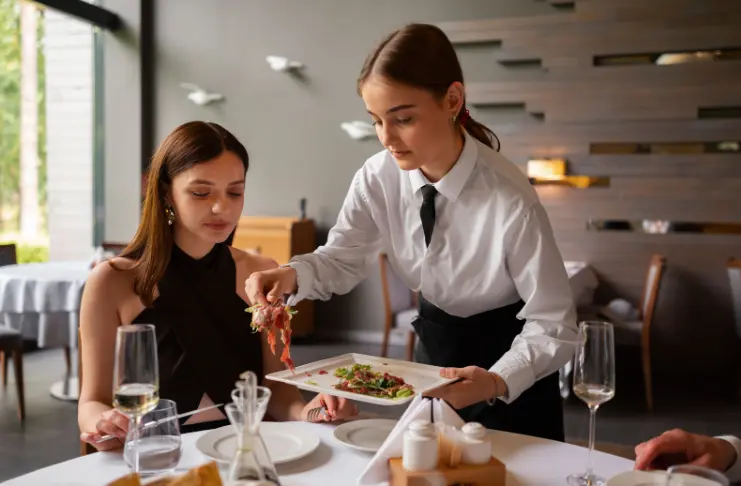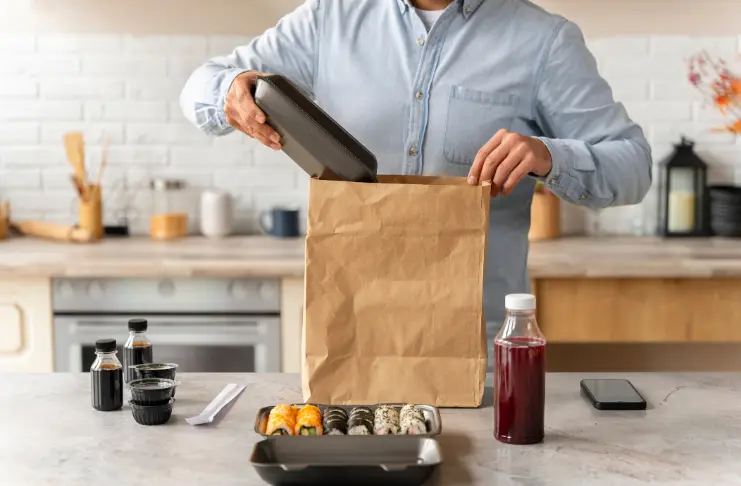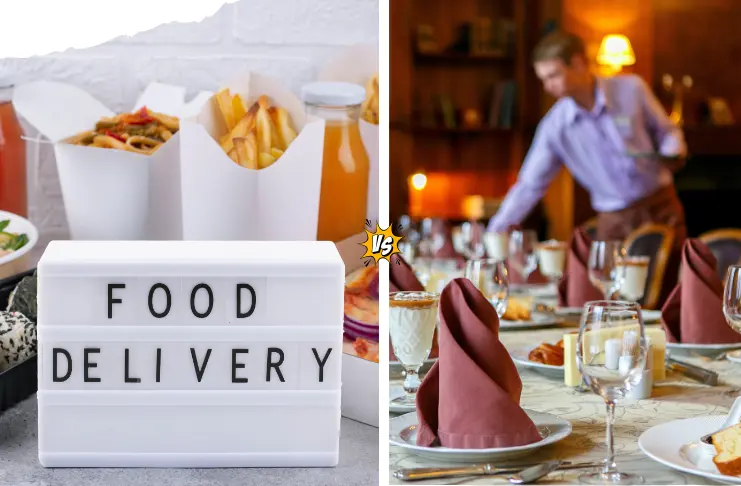For food entrepreneurs in the United States, one of the most critical early decisions is choosing the right restaurant format: a cloud kitchen or traditional restaurant. The pandemic accelerated the rise of virtual kitchens, while traditional brick-and-mortar establishments continue to reinvent themselves with hybrid models and experiential dining.
This blog will help you understand the difference between a cloud kitchen and a dine-in restaurant, weigh the pros and cons, and determine which is better based on your business vision, capital, and target audience.
What Is a Cloud Kitchen?

In the U.S., cloud kitchens – also called ghost kitchens or virtual kitchens – are delivery-only food establishments that rely on delivery services with no dine-in space. They prepare meals for off-premise consumption, relying on apps like Uber Eats, DoorDash, and Grubhub for order fulfillment. Key Characteristics of Cloud Kitchens in the U.S.:
- Operate from shared or private commercial kitchen spaces
- No customer-facing premises
- Technology-driven operations with real-time order integration
- Often serve multiple virtual brands from the same kitchen
INDUSTRY INSIGHT
| According to a report, the global cloud kitchen market was valued at $43.1 billion in 2019 and is expected to grow to $71.4 billion by 2027. This rapid expansion highlights the rising consumer preference for online food delivery, the cost-efficiency of delivery-only models, and the increasing investments by major food aggregators and restaurant operators. |
What Is a Dine-In Restaurant?

Dine-in restaurants offer an on-premises dining experience complete with service quality, seating, ambiance, and personalized guest interaction. They range from quick-service eateries and casual dining spots to fine-dining establishments.
Key Characteristics of Dine-In Restaurants:
Dine-in restaurants rely on a physical storefront to create a memorable experience for dine-in customers, focusing on ambiance, design, and brand identity to attract them.
- Physical storefront with branded ambiance
- High-touch customer service and interaction
- Diverse revenue streams (dining, events, takeout, delivery)
- Strong local community engagement
The State of the Restaurant Industry report notes that nearly 8 in 10 adults believe their favorite restaurant foods deliver flavors and taste experiences that are difficult to duplicate in a home kitchen.
While dine-in restaurants demand higher initial investment and operations management, they offer the potential for brand loyalty, premium pricing, and experiential dining.
Cloud Kitchen vs Dine-In Restaurant: A U.S. Market Comparison

In the U.S. food business, cloud kitchens and dine-in restaurants differ significantly in cost, space, operations, and customer interaction. Cloud kitchens operate solely through digital platforms with minimal face-to-face service, while dine-ins build loyalty through in-person dining experiences.
Startup costs for cloud kitchens range from $10,000 to $100,000, making them far more affordable than dine-in restaurants, which typically require $200,000 to $500,000+ due to expenses like interiors and staffing. Cloud kitchens operate in compact spaces (200–800 sq. ft.), while dine-ins need 1,500–4,000 sq. ft.
Cloud kitchens require fewer staff (2–5 employees), whereas dine-ins need larger teams for kitchen and front-of-house roles. Revenue in cloud kitchens comes mainly from delivery and pickup; dine-ins earn through on-site dining, takeout, events, and catering.
Cloud kitchens often enjoy higher profit margins (10–25%) and faster break-even (6–12 months), partly due to lower overhead costs compared to dine-ins (5–15% margins, 18–36 months to break even). They’re also more scalable due to lower investment and tech-driven growth.
Startup Costs: Cloud Kitchen vs Dine-In Restaurant
Understanding startup costs (equipment costs, set-up costs, etc.) is essential before launching your food business. These costs can vary drastically depending on your chosen model and market location.
Typical Cloud Kitchen Costs:
Cloud kitchens are generally more affordable to launch, with costs focused on kitchen space, staffing costs, equipment, tech, and compliance.
- Shared kitchen membership or lease: $2,000–$8,000/month
- Equipment and build-out (if private): $50,000–$100,000
- Marketing, branding, tech: $5,000–$15,000
- Licensing and insurance: $2,000–$5,000
Typical Dine-In Restaurant Costs:
Dine-in restaurants require a higher upfront investment due to space design, staffing, and customer-facing infrastructure.
- Lease and interior build-out: $150,000–$300,000+
- Furniture, kitchen equipment, design: $50,000–$200,000
- Staffing, training, soft launch: $25,000–$50,000
- Permits and insurance: $10,000–$25,000+
Choosing a model depends on how quickly restaurant owners want to launch, your financial resources, and whether your concept requires in-person ambiance or not.
Revenue Models and Profit Margins
How your restaurant makes money—and how much you keep—depends largely on your format.
Cloud Kitchen Revenue Model:
A cloud kitchen’s revenue model is centered around:
- Being fully delivery-focused via apps and direct ordering
- Having a lower average order size
- Experiencing reduced margins due to delivery fees and aggregator commissions (15–30%)
- Improving margins through strategies like cross-branding and shared staffing
Dine-In Restaurant Revenue Model:
A dine-in restaurant’s revenue model is characterized by:
- Generating most revenue from dine-in sales, with higher ticket sizes driven by ambiance and upselling
- Earning additional income from events, bar sales, and catering
- Facing higher operational costs, which lower net margins
Cloud kitchens can retain 20–25% profit margins if marketing and delivery costs are managed efficiently, while dine-in restaurants average 3–5%.
Customer Experience & Brand Loyalty
A brand’s ability to build emotional connection, and have high customer satisfaction rates depends heavily on the format.
Cloud Kitchens:
Cloud kitchens prioritize efficient delivery and packaging over direct customer interaction, relying on technology to drive loyalty.
- Limited interaction beyond app delivery
- Rely on packaging, prompt delivery, and online reviews
- Loyalty must be driven digitally
Dine-In Restaurants:
Dine-in restaurants offer rich, sensory experiences that help meet customer expectations and allow them to foster deep customer loyalty through personalized service and ambiance.
- Offers sensory and service-based experiences
- Builds deep brand attachment and repeat footfall
- Staff, ambiance, and food quality matter equally
If your concept thrives on human connection and community, dine-in gives you that edge. If you’re focused on efficiency and speed, cloud kitchens deliver.
Staffing & Operational Complexity
The operational model determines how complex your staffing and day-to-day tasks are.
Cloud Kitchen:
Cloud kitchens operate with smaller teams, which simplifies labor management and scheduling compared to the complex staffing needs of dine-in restaurants.
- Small, kitchen-focused teams (chef, prep cook, packager)
- No waitstaff or customer-facing employees
- Easier scheduling and labor management
Dine-In Restaurant:
Dine-in restaurants require larger teams to manage front-of-house and back-of-house operations, making staffing and training more complex.
- Requires FOH staff (host, waiters, bussers) and BOH team
- Complex shift management, tip pooling, and training
- High employee turnover and service consistency challenges
In the U.S. restaurant industry, labor costs typically range between 25% and 35% of total revenue
Location Strategy & Rent
Real estate costs are one of the biggest differences between formats.
Cloud Kitchens:
Cloud kitchens require less prime real estate, as their focus is on serving delivery areas rather than attracting walk-in traffic.
- Can operate from industrial kitchens, warehouse zones, or shared spaces
- Focus is on delivery radius, not street visibility
- Flexible leasing models are available in most major cities
Dine-In Restaurants:
Dine-in restaurants must secure prime locations with high foot traffic, which often means paying higher rent for better visibility.
- Need prime locations with foot traffic and parking access
- Aesthetic storefronts and compliance with zoning
- Long-term leases and high CAM fees
While location is crucial for a dine-in restaurant’s success, it comes at a higher cost, influencing overall profitability.
Technology & Tools
Both formats need technology, but the nature and intensity differ.
Cloud Kitchens:
Cloud kitchens rely heavily on technology to manage online orders, track deliveries, and optimize kitchen processes.
- Online ordering, POS integration, and delivery platform APIs
- Real-time order tracking, automated KDS, and ghost kitchen software
- Third-party or white-label marketing tools
Dine-In Restaurants:
Dine-in restaurants also utilize technology for reservations, POS systems, and customer management, though their focus is more on enhancing the in-house experience.
- Reservation systems, table management, and CRM tools
- POS integration with in-house and takeout services
- Loyalty apps and feedback systems
Tech adoption is vital in both formats, but is more core to cloud kitchen sustainability.
Expansion Potential & Scalability
Growth looks different for cloud vs. dine-in formats.
Cloud Kitchens:
Cloud kitchens offer fast, low-cost expansion in the restaurant business thanks to their digital model, minimal overhead, and reliance on delivery platforms.
- Easily launch new locations or brands with minimal CapEx
- Multi-brand, single-kitchen models allow efficient scaling
- Partnerships with ghost kitchen platforms (e.g., CloudKitchens, Kitchen United)
Dine-In Restaurants:
Dine-in restaurants need more investment to scale—covering real estate, ambiance, and staffing.
- Expansion requires new build-outs, staff, and brand replication
- Franchising or licensing is often the route to scale
- High-cost barrier slows multi-unit growth
If rapid, multi-market expansion is your goal, cloud kitchens provide a faster track.
Pros and Cons
Here’s a concise breakdown of each model’s strengths and drawbacks:
Cloud Kitchen Pros:
Cloud kitchens come with several operational and financial advantages that make them attractive for new-age foodpreneurs, especially in major urban centers across the U.S.
- Lower startup and operating costs
- Fast launch and scale
- Ideal for delivery-heavy demographics
Cloud Kitchen Cons:
Despite their perks, cloud kitchens also come with limitations—mostly tied to their lack of customer-facing infrastructure and dependency on tech platforms.
- No customer interaction
- Heavy reliance on third-party delivery apps
- Harder to build a brand offline
Dine-In Restaurant Pros:
These drawbacks may restrict long-term brand building and customer retention if not addressed through strong online marketing and partnerships.
- Full brand immersion and customer loyalty
- Higher per-customer spend
- Greater event and community integration
Dine-In Restaurant Cons:
On the flip side, the traditional restaurant model carries substantial financial and operational burdens that can limit agility and profitability.
- High CapEx and overheads
- Slower scale and breakeven
- Staffing and operational complexity
Neither format is objectively better—it’s about alignment with your business goals.
When Should You Choose a Cloud Kitchen?

Certain business models and market scenarios are better suited for cloud kitchens—particularly those focused on efficiency, digital reach, and rapid experimentation. Opt for a cloud kitchen if:
- You’re targeting high-delivery zones like college campuses or urban hubs
- You want to test multiple food concepts quickly
- You have limited startup capital
- You aim to optimize margins using automation
If you want to optimize for speed, cost-efficiency, and multi-brand delivery in high-demand areas, a cloud kitchen is your ideal entry point.
When Should You Choose a Dine-In Restaurant?

Dine-in formats shine when the business goal is to deliver a memorable, physical dining experience and foster long-term brand affinity. Choose a dine-in format if:
- You’re building a hospitality-focused or fine-dining brand
- Your cuisine relies on presentation, service, or ambiance
- You’re located in a high-footfall neighborhood
- You can manage and scale a staff-heavy business
For those passionate about hospitality, experiential dining, and neighborhood-based growth, dine-in restaurants remain a fulfilling and powerful business model.
U.S. Food Industry Trends to Watch

The line between formats is blurring in 2025 and beyond. Stay updated with these trends:
- Hybrid dine-in + delivery models are emerging
- Ghost kitchen franchises are gaining popularity
- AI and predictive analytics for demand planning
- Focus on sustainable packaging and carbon neutrality
The future of the food business is hybrid, tech-enabled, and customer-centered—no matter the format.
Conclusion
Choosing between a cloud kitchen vs dine-in restaurant isn’t just about budget—it’s about vision. Cloud kitchens win on speed, scale, and efficiency. Dine-in restaurants win on experience, brand loyalty, and community. Your decision should reflect your brand identity, financial plan, and customer base.
Clarity in format is the foundation of your success.
Frequently Asked Questions
1. What is the difference between cloud kitchen and dine-in?
A cloud kitchen is delivery-only with no physical dining space, while a dine-in restaurant offers on-site seating and customer service.
2. What is the difference between cloud kitchen and ghost kitchen?
Both operate for delivery, but “ghost kitchen” is a broader term that may house multiple brands in one space, while a cloud kitchen is often a single virtual brand.
3. What does cloud kitchen mean?
A cloud kitchen is a commercial kitchen that prepares food exclusively for online delivery orders, with no dine-in facility.
4. What is the difference between QSR and cloud kitchen?
QSRs (Quick Service Restaurants) offer fast food with dine-in or takeaway options, while cloud kitchens are delivery-only with no customer-facing area.
5. What is considered a dine-in restaurant?
A dine-in restaurant provides a physical space for guests to sit, order, and enjoy their meals on-site.
6. What is the difference between cloud kitchen and dine in?
Cloud kitchens focus solely on delivery without seating, while dine-in restaurants offer table service and in-person dining.
7. What are the disadvantages of ghost kitchens?
Ghost kitchens face challenges like low brand visibility, dependence on delivery apps, limited customer interaction, and fierce online competition.
8. What is the difference between cloud kitchen and virtual kitchen?
They’re often used interchangeably, but a virtual kitchen typically refers to a brand that exists only online, while a cloud kitchen refers to the physical space where such brands operate.
9. Which type of layout is best for restaurant?
An open kitchen layout with efficient workflow zones (prep, cook, serve, clean) is ideal for visibility, safety, and speed in modern restaurants.
10. What are the 4 P’s of a restaurant?
Product (food & service), Price, Place (location/delivery), and Promotion (marketing) — the core elements of a restaurant’s marketing strategy.





